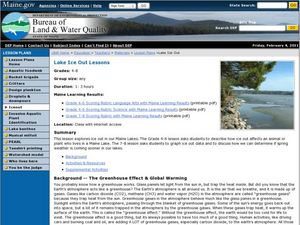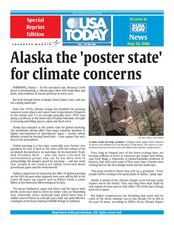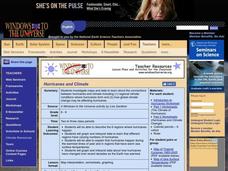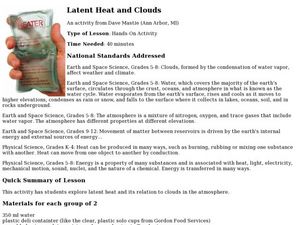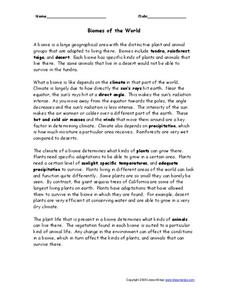Curated OER
Climate and Temperature
Students explore what the soil temperature would be on the north and south sides of a building. In this temperature lesson, students hypothesize what the results will be using a thermometer and then after a week see what the temperatures...
Curated OER
Lake Ice Out Lessons
Students explore the greenhouse effect. In this environment lesson, students describe how "ice out" affects animals and plants who live in a Maine lake. Students graph "ice out" data and make predictions about the upcoming weather.
Curated OER
What Does Plant Biology Teach Is About Climate?
Learners examine what factors influence climate. In this investigative activity students compare the factors that influence climate and how they effect tree growth.
Curated OER
Alaska the 'Poster State" For Climate Concerns
Students read an article on Alaska and its climate concerns. In this research lesson students create a poster that contrasts Alaska then and now that pertains to climate change.
Curated OER
United States & Canada: How Are We The Same? How Are We Different?
Pupils compare and contrast similarities and differences between Canada and the US. In this geography lesson, students read various articles and identify similarities and differences in economies, cultures, geography, climate, and...
Curated OER
Hurricanes and Climate
Students investigate maps and data to learn about the connections between hurricanes and climate. In this exploratory lesson students describe and graph the 6 regions where hurricanes happen and discuss how hurricanes have changed over...
Curated OER
Why Is Climate Important to Growing Rice?
Third graders determine the location of major rice producing states in the United States. In this rice production lesson, 3rd graders locate the longitude and latitude of each rice producing state. They color the states and indicate...
Curated OER
Latent Heat and Clouds
Learners explore latent heat and how it relates to clouds in the atmosphere. In this earth science lesson students investigate how clouds are formed. Learners examine clouds and the water cycle.
Curated OER
Our Eye in the Sky: The TIROS Weather Satellite
Students investigate the political context of the creation of a weather satellite. In this technology and society lesson, students explore the historical, technological, and political context of the TIROS weather satellite. They write a...
Curated OER
Changing Weather: Comparing Climate from Voyageur Times to Today
Fifth graders compare climates. In this weather lesson, 5th graders observe and record weather observations and discuss the impact of weather on people. Students also discuss the concept of global warming and determine how weather...
Curated OER
Where in the World is Utah Wheat?
Students examine the role of climate and landforms in the use of Utah's land. In this geography lesson, students analyze the relationship between geography and agriculture in the state as they examine data regarding wheat production in...
Curated OER
"Pass the Potatoes" (But, where did they come from?)
Eighth graders explore various cultures around the world. In this cultural lesson, 8th graders prepare foods that belong to different cultures. Students examine the climate in the places of origin of their foods using a map. Students...
Curated OER
Rising Air
Young scholars investigate the concept of rising air in the formation of clouds and precipitation. In this rising air lesson, students conduct an experiment with hot and cold water that shows how warm water rises due to thermal buoyancy....
Curated OER
Global Warming
Students read information about global warming and make their own greenhouse. In this global warming lesson, students read several pages of global warming and climate information. Students then make their own greenhouse and answer...
Curated OER
Shackleton's Antarctic Adventure
Young scholars research the exploration of Antarctica by the explorer Sir Ernest Shackelton. In this Antarctic exploration lesson, students watch a movie about Sir Ernest Shackelton and his ship the Endurance. Young scholars study a map...
Curated OER
Glaciers: Then and Now
Learners compare glaciers then and now. For this glaciers lesson, students learn what glaciers are, how they grow and retreat, the types of glaciers and how they are affected by climate conditions. Learners match glacier images from the...
Curated OER
Climate and Cultures of Africa
Young scholars gain an understanding of the relationship between climate and culture in the sub- Saharan Africa. Students will complete short exercises pertaining to the various cultures of Africa and the climate in which they live....
Curated OER
Bellwork for Week 16-Climate
In this bellwork worksheet, students answer a variety of questions about the climate, climographs, biomes and factors that control climate.
Curated OER
Rain Forest Characteristics
In this earth science worksheet, students answer 5 questions about the rain forest. They write about the characteristics of this biome, and describe the animals, plants, location, and climate.
Curated OER
Farming - Ireland
In this farming activity, students explain what is meant by sustainable development. Students review how rain develops. Students determine how climate effects crops that can be farmed. This activity has 4 graphic organizers, 1 graph, 20...
Curated OER
Biomes of the World
In this biomes worksheet, students read an article on biomes and answer 10 multiple choice, short answer or true and false questions relating to biomes.
Curated OER
Rainforests Rule
For this rainforests worksheet, students read for information and assess comprehension skills. In this true and false, multiple choice, and fill-in-the-blank worksheet, students answer ten questions.
Curated OER
What is Climate?
In this weather worksheet, students read a brief excerpt that compares the various types of climates found on Earth. Then they explain where the low- and high-pressure systems follow each other throughout the year.
Curated OER
What is Climate?
In this weather worksheet, students identify and explain the factors that can affect the climate in each area of the illustrated map. Then they describe the various effects of these factors, such as air pressure systems and the land...



